The Tourist Attractions in Moshi are many considering that it is located at the foot of Mount Kilimanjaro close to the border with Kenya. Moshi stands out because of the remarkable scenery and striking views of the mountain from every corner. Moshi sits on an altitude of about 890 meters and hence has cool weather for most the year. The volcanic soils on the mountain slopes is very fertile allowing for coffee and bananas to thrive. Moshi is one of the two leading coffee producing towns in Tanzania and you will know this from the sweet smelling air coming from the main coffee processing factory.
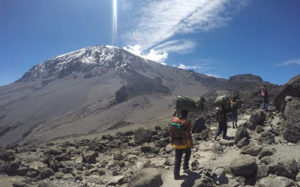 Three main tribal groups call Moshi home – The Chagga, Pare and Maasai. The Chagga are the dominant tribe in the town and surrounding villages. They are known for their hard work, business acumen and friendly nature. The Masai homesteads are further north and away from the town. Most of the Masai in Moshi town are employed as watchmen or come to sell their traditional handcrafts and medicines. The main language spoken in the town is Swahili but you will find that most people on the street speak good English.
Three main tribal groups call Moshi home – The Chagga, Pare and Maasai. The Chagga are the dominant tribe in the town and surrounding villages. They are known for their hard work, business acumen and friendly nature. The Masai homesteads are further north and away from the town. Most of the Masai in Moshi town are employed as watchmen or come to sell their traditional handcrafts and medicines. The main language spoken in the town is Swahili but you will find that most people on the street speak good English.
Although Moshi is a coffee and sugar producing town, tourism is very important to the economy of the town. Most tourist who visit Moshi do so on their way to and from climbing Mount Kilimanjaro. Others visit the town while on a safari in the nearby national parks of Serengeti, Arusha, Lake Manyara and the Ngorongoro Crater. Unfortunately, most tourists only spend a night or two in the town and rarely take time to discover the town.
Moshi has a lot to offer for visitors who are interested as you will discover in the following chapters. From breathtaking scenery, waterfalls, hot springs, restaurants, night clubs, museums, artisan shops to amazing wildlife, Moshi has it all in store for tourists. You can read a related article about the things to do in Arusha or tourist attractions in Dar es Salaam. We also have an article about the activities in Zanzibar.
Tourist Attractions in Moshi Tanzania
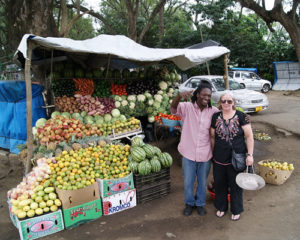 Explore all corners of the town: One of the best ways to discover the town of Moshi is by touring the center and suburbs. This can be done by walking, taking a daladala, bicycle or motorcycle. The starting point will depend on your location but it’s better to start your tour at the town center before moving to the suburbs. You can begin by checking out the town shops, restaurants and inner streets. After exploring the ton center, you can proceed to the residential areas outside the town center and finally to the town slums. For the best views of the town, we highly recommend spending time relaxing at the sitting area on the top floor of Selig Hotel. You could spend the entire day watching residents go about their day while enjoying the amazing views of Mount Kilimanjaro.
Explore all corners of the town: One of the best ways to discover the town of Moshi is by touring the center and suburbs. This can be done by walking, taking a daladala, bicycle or motorcycle. The starting point will depend on your location but it’s better to start your tour at the town center before moving to the suburbs. You can begin by checking out the town shops, restaurants and inner streets. After exploring the ton center, you can proceed to the residential areas outside the town center and finally to the town slums. For the best views of the town, we highly recommend spending time relaxing at the sitting area on the top floor of Selig Hotel. You could spend the entire day watching residents go about their day while enjoying the amazing views of Mount Kilimanjaro.
Learn Swahili: Swahili is easy to learn because every word is written just as it sounds. You can survive with your knowledge of English alone but Tanzanians develop a soft spot for those who can speak some of Swahili. The first word to master is Jambo meaning “greetings”.
Visit the Soweto Memorial Market: Visiting the main market is the first thing one should consider when visiting a new town. Why? Because it is the best place to experience the kind of life lived by the 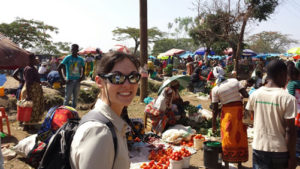 people in the area. It is only in a market that you get to meet all classes of people. The Soweto Memorial Market in Moshi is excellent for home shopping if you are in town for a few weeks or months. This is where you get the freshest vegetables, passion fruits, mangoes, avocado and papaya. The central market also sells other household items, local fabrics and second hand clothes. The market is very busy and if you are keen enough, you might even here some of the local gossip. Prepare to bargain and expect higher prices for those who look like international tourists.
people in the area. It is only in a market that you get to meet all classes of people. The Soweto Memorial Market in Moshi is excellent for home shopping if you are in town for a few weeks or months. This is where you get the freshest vegetables, passion fruits, mangoes, avocado and papaya. The central market also sells other household items, local fabrics and second hand clothes. The market is very busy and if you are keen enough, you might even here some of the local gossip. Prepare to bargain and expect higher prices for those who look like international tourists.
Visit the Night Clubs and Bars: Moshi may be a small town but the folks there love to party. From Friday evening to Sunday Morning, the town comes to life as almost every adult is out partying. If you love to party through the night or are just looking for a cool place hangout and meet new people, we 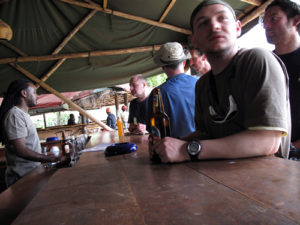 recommend Redstone, Pamoja Bar, the Police mess, Malindi Club, the Siesta inn, Kool Bar, The East Africa Bar, Black Diamond, Pub Alberto, Glaciers and Peter’s Club. Pamoja bar is a favorite hangout place for volunteers, expatriates and tourists. There is a resident DJ playing the latest local and international hits. You can spend the evening playing pool with revelers as you catch the latest sports news or take a bottle of local beer (Safari, Kilimanjaro or Tusker beer). Moshi’s answer to vodka is Konyagi. Malindi Club plays some of the best international hits and invites local musicians to perform live music every Friday evening. If you are not comfortable with noisy places, then try Kool Bar or Peter’s Club. These two relatively quiet hangout joints are close to each other and are excellent for meetings friends for a chat. If you want to best cocktails, Chicken BBQ and great music, then you should go to Glaciers.
recommend Redstone, Pamoja Bar, the Police mess, Malindi Club, the Siesta inn, Kool Bar, The East Africa Bar, Black Diamond, Pub Alberto, Glaciers and Peter’s Club. Pamoja bar is a favorite hangout place for volunteers, expatriates and tourists. There is a resident DJ playing the latest local and international hits. You can spend the evening playing pool with revelers as you catch the latest sports news or take a bottle of local beer (Safari, Kilimanjaro or Tusker beer). Moshi’s answer to vodka is Konyagi. Malindi Club plays some of the best international hits and invites local musicians to perform live music every Friday evening. If you are not comfortable with noisy places, then try Kool Bar or Peter’s Club. These two relatively quiet hangout joints are close to each other and are excellent for meetings friends for a chat. If you want to best cocktails, Chicken BBQ and great music, then you should go to Glaciers.
Climbing Mount Kilimanjaro: The first thing that catches your eye when approaching Moshi is the amazing snow-capped peak of Mount Kilimanjaro. This dormant volcano is the highest mountain in Africa. It rises up to 5,895 meters above sea level and its peak is sometimes referred to as the “Roof of Africa”. Mount Kilimanjaro receives about 45,000 tourists each year and reaching its summit is 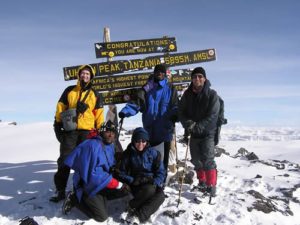 considered one of the most challenging in the world. You don’t have to be a seasoned mountain hiker to get the top. All you need is mental preparedness and a certain level of fitness. Hiking the mountain takes between five to ten days depending on your budget, ability and time at your disposal. There are 7 different hiking routes all leading up to the summit including Umbwe, Shira, Rongai, Mweka, Marangu, Machame and Lemosho. Each route offers a different experience in terms of scenery (wildlife, volcanic features, forests, coffee and banana plantations) and climatic zones. Machame is thought to be the most difficult route but with the best scenery. Regardless of which route you choose to use, you will be rewarded by great views of the nearby towns, national parks and Mount Meru. If you have little time to spare or are tight on budget, you can opt for the one-day Mount Kilimanjaro hike which leads to the Mandara hut.
considered one of the most challenging in the world. You don’t have to be a seasoned mountain hiker to get the top. All you need is mental preparedness and a certain level of fitness. Hiking the mountain takes between five to ten days depending on your budget, ability and time at your disposal. There are 7 different hiking routes all leading up to the summit including Umbwe, Shira, Rongai, Mweka, Marangu, Machame and Lemosho. Each route offers a different experience in terms of scenery (wildlife, volcanic features, forests, coffee and banana plantations) and climatic zones. Machame is thought to be the most difficult route but with the best scenery. Regardless of which route you choose to use, you will be rewarded by great views of the nearby towns, national parks and Mount Meru. If you have little time to spare or are tight on budget, you can opt for the one-day Mount Kilimanjaro hike which leads to the Mandara hut.
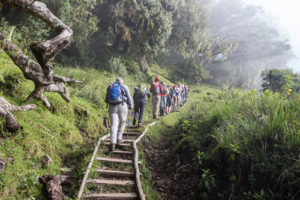 Hiking Mount Meru: Climbing Mount Meru is considered a good practice ground for those who are planning to hike Mount Kilimanjaro. It is the second highest mountain in Tanzania at 4,566 meters and one of the highest in Africa. Hiking Mount Meru is also suitable for those who may find Kilimanjaro too expensive. Many hikers have found the experience of climbing Mount Meru even better than Kilimanjaro because of the scenery and the exposure to the wildlife in Arusha National Park. Expect
Hiking Mount Meru: Climbing Mount Meru is considered a good practice ground for those who are planning to hike Mount Kilimanjaro. It is the second highest mountain in Tanzania at 4,566 meters and one of the highest in Africa. Hiking Mount Meru is also suitable for those who may find Kilimanjaro too expensive. Many hikers have found the experience of climbing Mount Meru even better than Kilimanjaro because of the scenery and the exposure to the wildlife in Arusha National Park. Expect 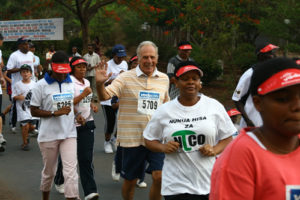 explore the famous Momella Lakes, enjoy the incredible biodiversity and encounter wild animals.
explore the famous Momella Lakes, enjoy the incredible biodiversity and encounter wild animals.
The Kilimanjaro marathon: This event is organized in early March of every year. Thousands of people regardless of fitness level register to run for 3 categories of races (5, 21 and 42 kilometers). If you happen to visit in March, ensure that you participate. You will enjoy the experience and have fun while interacting with the local people. The running routes go around some of the best 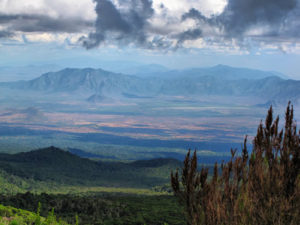 parts of the town and countryside.
parts of the town and countryside.
The Pare mountains: These mountains are found in a quiet village, south of Moshi. The mountains remain relatively unexplored because most hikers prefer the challenge of Kilimanjaro and Meru. However, if you love doing something different and nature, you will find the Pare mountains amazing. They are surrounded by beautiful forests and excellent hiking trails that will impress any adventurous visitor. You can also visit the nearby Lake Jipe and go out fishing with the local fishermen or see hippos and elephants especially in the morning hours.
Play Golf at the Moshi Club: Moshi town has one of the oldest and most beautiful golf courses in Tanzania. The 9-hole golf course is found at the foot of Mount Kilimanjaro and about 4 kilometers away 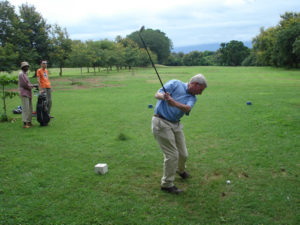 from the town center. The golf course covers a total area of about 90 acres and is a member of the wider Tanzania Golf Union which manages all golfing activities in the country. The Moshi Club manages the golf course and was founded in 1920. Over the years, the Club has hosted and won many national golf completions. The club has a membership of about 100 individuals but not all are active members. Most join the club for the prestige and opportunities it offers in terms of making important connections. Expect to find international tourists, local businessmen and politicians.
from the town center. The golf course covers a total area of about 90 acres and is a member of the wider Tanzania Golf Union which manages all golfing activities in the country. The Moshi Club manages the golf course and was founded in 1920. Over the years, the Club has hosted and won many national golf completions. The club has a membership of about 100 individuals but not all are active members. Most join the club for the prestige and opportunities it offers in terms of making important connections. Expect to find international tourists, local businessmen and politicians.
Hire a Bike of Motorcycle for a town tour: If you are not interested in the boda bodas, taxis and daladalas, you can rent a motorcycle for the duration of your stay in the town. Motorcycles or bicycles are comfortable and flexible. You also don’t need to worry about the traffic in Moshi.
Coffee and Banana Plantation Tours: As a coffee town, Moshi is an excellent place to go and discover how the beverage is grown and processed. Most of the private coffee plantations are found at the foot of the Mount Kilimanjaro and in villages like Materuni. To reach the plantations, you might 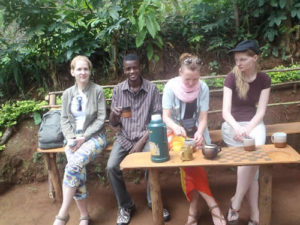 need a to hire personal car or daladala and take a journey of roughly 15 kilometers. The coffee tour is often led by one of the farmers. Expect to learn about the entire coffee planting process – the planting, best season, how it is roasted and how farmers find market for their products. Visiting the private coffee plantations will give you firsthand experience of just how difficult it is to come up with the final products. If time is not on your side, you can choose to take coffee from within town itself and at a reasonable price. The Coffee Union at the city center is the most popular Arabica coffee shop in town and they have been in business since the 1930’s. I shouldn’t forget to mention that apart from coffee, bananas also do amazingly well in Moshi. Most of the bananas are eaten as food or used to make local beer.
need a to hire personal car or daladala and take a journey of roughly 15 kilometers. The coffee tour is often led by one of the farmers. Expect to learn about the entire coffee planting process – the planting, best season, how it is roasted and how farmers find market for their products. Visiting the private coffee plantations will give you firsthand experience of just how difficult it is to come up with the final products. If time is not on your side, you can choose to take coffee from within town itself and at a reasonable price. The Coffee Union at the city center is the most popular Arabica coffee shop in town and they have been in business since the 1930’s. I shouldn’t forget to mention that apart from coffee, bananas also do amazingly well in Moshi. Most of the bananas are eaten as food or used to make local beer.
Become a Volunteer: One of the best ways to contribute to society is by volunteering. A number of Organizations are willing to accept volunteers. You can register to teach in a school, work in a clinic or with the youth/women in the area. If you are already in town, the best way to get a volunteer assignment is by visiting any of the schools, churches and clinics and inquire of they allow volunteers. Most will 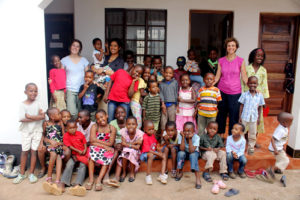 gladly accommodate international volunteers. If you are not yet in the country, you can look for a volunteering spot through a Volunteer organization or your tour company. You need to take time learning about their work and visit their website to see what they are actually doing. Many organizations for the needy in Africa have good intentions but are poorly funded or do not have good management. You need to ignore these weaknesses and focus on the bigger picture which is to make an impact and have a fulfilling experience. Some of the organizations you can look up to for volunteer opportunities are the Global Volunteer Programs Kilimanjaro, Light of Africa, Moyo Mmoja, give a Heart to Africa, Hostel Foot Prince, Teatem and World Unite. All of them have websites and all you need to do is search for each of them on google.
gladly accommodate international volunteers. If you are not yet in the country, you can look for a volunteering spot through a Volunteer organization or your tour company. You need to take time learning about their work and visit their website to see what they are actually doing. Many organizations for the needy in Africa have good intentions but are poorly funded or do not have good management. You need to ignore these weaknesses and focus on the bigger picture which is to make an impact and have a fulfilling experience. Some of the organizations you can look up to for volunteer opportunities are the Global Volunteer Programs Kilimanjaro, Light of Africa, Moyo Mmoja, give a Heart to Africa, Hostel Foot Prince, Teatem and World Unite. All of them have websites and all you need to do is search for each of them on google.
Chemka/Kikuletwa Hot spring: The Chemka is one of the most beautiful natural hot springs in Tanzania. It is located in the middle of an arid landscape (the Sanya plains) in the village of Rundugai. 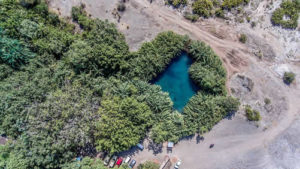 The boiling/bubbling water comes from underground and by the time it reaches up, it is warm enough to allow for swimming. Rundugai village is found between Moshi town and Kilimanjaro airport. You can get amazing views of two of Africa’s tallest mountains (Mount Meru and Kilimanjaro). The waters offer a soothing power and are surrounded beautiful scenery, baobab trees and natural caverns. Apart from swimming in the hot spring, you can also go for primates viewing, birdwatching and cultural visits to one local tribes in the area. If you find the place amazing, you can choose to camp for the night. It takes 1.5 hours of driving by road to reach the hot spring.
The boiling/bubbling water comes from underground and by the time it reaches up, it is warm enough to allow for swimming. Rundugai village is found between Moshi town and Kilimanjaro airport. You can get amazing views of two of Africa’s tallest mountains (Mount Meru and Kilimanjaro). The waters offer a soothing power and are surrounded beautiful scenery, baobab trees and natural caverns. Apart from swimming in the hot spring, you can also go for primates viewing, birdwatching and cultural visits to one local tribes in the area. If you find the place amazing, you can choose to camp for the night. It takes 1.5 hours of driving by road to reach the hot spring.
Visit the Masai Cultural Museum/Village (Olpopongi): The Masai are without doubt one of Africa’s most intriguing tribes. The Masai are related to the Nuer and Dinka tribes in South Sudan. They are relatively tall people and stand out from other especially when they put on their brightly colored shukas. Most Masai are nomadic pastoralists who live close to national parks in Tanzania and Kenya. Many now move around different towns trying to make ends meet.
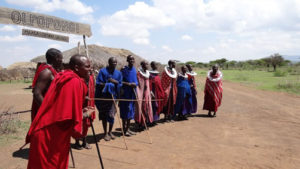 To understand the Masai and their way of life, one needs to visit the Masai Cultural Village and Museum is the western part of Kilimanjaro. This cultural village is found 74 kilometers away from Moshi town – between Arusha and Moshi. The Centre provides a unique opportunity for tourists to experience authentic Masai culture and life. It was built by the government in order avoid taking tourists to individual Masai homes – something that could impact on their environment and traditional ways of life. The Masai Cultural Village was built to resemble a typical Masai homestead. It is a large facility with Manyattas, kraals and Masai people. While at the village, you can learn about their religious, political and social structures. You will learn about the role of the husband, wife in the family structure. The Masai are friendly and willing to share information about their history, nomadic life and how it connects to many of the national parks in the area.
To understand the Masai and their way of life, one needs to visit the Masai Cultural Village and Museum is the western part of Kilimanjaro. This cultural village is found 74 kilometers away from Moshi town – between Arusha and Moshi. The Centre provides a unique opportunity for tourists to experience authentic Masai culture and life. It was built by the government in order avoid taking tourists to individual Masai homes – something that could impact on their environment and traditional ways of life. The Masai Cultural Village was built to resemble a typical Masai homestead. It is a large facility with Manyattas, kraals and Masai people. While at the village, you can learn about their religious, political and social structures. You will learn about the role of the husband, wife in the family structure. The Masai are friendly and willing to share information about their history, nomadic life and how it connects to many of the national parks in the area.
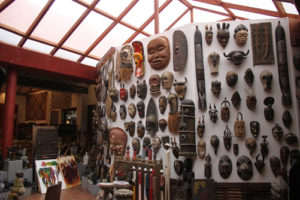 Buy souvenirs from artisan shops: One of the most interesting part of traveling is acquiring something that will always remind you of a particular place. Tanzanians are great artists and you will have many options and places to buy souvenirs. Some of the best souvenir shops are Blue Zebra located in Kibo Tower and Chui’s Trading Limited. Blue Zebra has a collection of hand built handbags, toys and local clothes. Chui’s Trading Limited has artisan products, local fabrics and souvenir T-shirts. You should not limit your options to these two because there are other artisan shops worth considering. Most of the hotels have their own souvenir shops but they can be quiet expensive.
Buy souvenirs from artisan shops: One of the most interesting part of traveling is acquiring something that will always remind you of a particular place. Tanzanians are great artists and you will have many options and places to buy souvenirs. Some of the best souvenir shops are Blue Zebra located in Kibo Tower and Chui’s Trading Limited. Blue Zebra has a collection of hand built handbags, toys and local clothes. Chui’s Trading Limited has artisan products, local fabrics and souvenir T-shirts. You should not limit your options to these two because there are other artisan shops worth considering. Most of the hotels have their own souvenir shops but they can be quiet expensive.
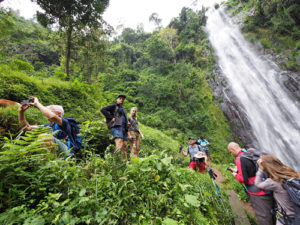 The Materuni waterfalls: The Materuni Waterfalls are found outside the town of Moshi. They are surrounded by beautiful valleys, hills, coffee/banana plantations and rainforest. Day tours are arranged to discover this hidden attraction to discover the waterfalls or get amazing views of the Mount Kilimanjaro and Moshi Town. Hiking to the top of these waterfalls can be physically demanding especially if one is not mentally prepared or used to walking in mountainous areas. On the way to or back from the waterfalls, tourists can stop for a cultural encounter with the main local tribe. The Chagga people in the area are known for growing large coffee and banana plantations. They are a very progressive, resourceful and hardworking tribe.
The Materuni waterfalls: The Materuni Waterfalls are found outside the town of Moshi. They are surrounded by beautiful valleys, hills, coffee/banana plantations and rainforest. Day tours are arranged to discover this hidden attraction to discover the waterfalls or get amazing views of the Mount Kilimanjaro and Moshi Town. Hiking to the top of these waterfalls can be physically demanding especially if one is not mentally prepared or used to walking in mountainous areas. On the way to or back from the waterfalls, tourists can stop for a cultural encounter with the main local tribe. The Chagga people in the area are known for growing large coffee and banana plantations. They are a very progressive, resourceful and hardworking tribe.
Tarangire National Park: The popularity of the Serengeti national park has stopped many a tourist from discovering one of Tanzania’s true gems – the Tarangire National Park. Had it been found in a 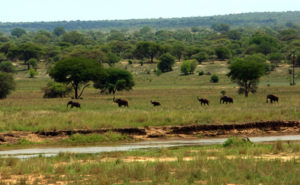 country like Rwanda for example, it would receive 10 times more visitors than it does at the moment. A safari in Tarangire National Park is relatively cheap compared to one at the Serengeti. Moreover, you get to see many of the mammals of the Serengeti including lions, giraffes, gazelle, Impala, Leopards, cheetahs, wildebeest, zebras and the largest number of Elephants in the world. Most of the animals congregate around a large waterhole close to the park entrance. The best time to visit Tarangire is in the months of June to October. Many of the park animals migrate to other national parks in the months between November and May but you can still go and spot those that remain behind.
country like Rwanda for example, it would receive 10 times more visitors than it does at the moment. A safari in Tarangire National Park is relatively cheap compared to one at the Serengeti. Moreover, you get to see many of the mammals of the Serengeti including lions, giraffes, gazelle, Impala, Leopards, cheetahs, wildebeest, zebras and the largest number of Elephants in the world. Most of the animals congregate around a large waterhole close to the park entrance. The best time to visit Tarangire is in the months of June to October. Many of the park animals migrate to other national parks in the months between November and May but you can still go and spot those that remain behind.
Visit Lake Chala: Lake Chala is a crater lake found at the edge of Mount Kilimanjaro along the border between Kenya and Tanzania. It was formed 3 million years ago as a result of a major volcanic eruption. The lake is surrounded by a crater rim (100 meters high) and has a depth of about 3 kilometers. Lake Chala is the deepest inland water body in Africa. The lake changes color depending on the month of the year ranging from deep blue to crystal clear waters in some months. Most of the water is drained and filled by underground streams.
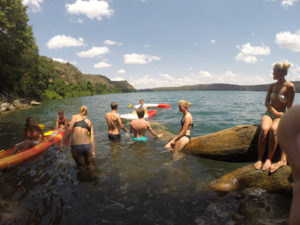 A day trip to the crater lake rewards visitors with great views of the area, Mount Kilimanjaro and the savannah grasslands. The lake offers a rare tranquil environment, fresh air and an opportunity to be close to nature. One can choose to go for birding, kayaking, canoeing and nature walks in the forest surrounding the lake. On a good day, you might even find a herd of elephants cooling by the shores of the lake, monitor lizards, small monkeys, baboons, snakes and monitor lizards. Lake Chala is an excellent place to escape the noise in the town and it’s only an hour’s drive away from the town center. We recommend that you spend at least a night in one of the quality tented lodges at the site. The government charges a small amount to enter the lake area.
A day trip to the crater lake rewards visitors with great views of the area, Mount Kilimanjaro and the savannah grasslands. The lake offers a rare tranquil environment, fresh air and an opportunity to be close to nature. One can choose to go for birding, kayaking, canoeing and nature walks in the forest surrounding the lake. On a good day, you might even find a herd of elephants cooling by the shores of the lake, monitor lizards, small monkeys, baboons, snakes and monitor lizards. Lake Chala is an excellent place to escape the noise in the town and it’s only an hour’s drive away from the town center. We recommend that you spend at least a night in one of the quality tented lodges at the site. The government charges a small amount to enter the lake area.
Kilimanjaro Animal Crew: This facility is found on the slopes of Mount Kilimanjaro in Makoa Farm. The Centre was built to cater for rescued, injured and orphaned animals from national parks in the area. 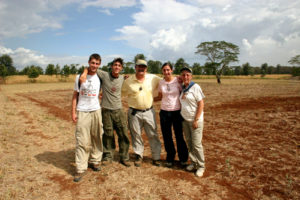 The animals are released back into the wild once new individuals arrive at the facility. Kilimanjaro Animal Crew helps sensitize people about the importance of wildlife conservation. There is a large population of primates around the facility and visitors should expect close encounters with small monkeys and chimpanzees. There are also serval cats, wild donkeys, bush pigs, duikers and marabou storks among other animals. The animals are both tame and wild and caution should be exercised when feeding or near them. A typical day at the Centre involves walking around the facility and checking out all the animals under the guidance of a trained Guide. The best time to visit the facility is during feeding time at 4pm.
The animals are released back into the wild once new individuals arrive at the facility. Kilimanjaro Animal Crew helps sensitize people about the importance of wildlife conservation. There is a large population of primates around the facility and visitors should expect close encounters with small monkeys and chimpanzees. There are also serval cats, wild donkeys, bush pigs, duikers and marabou storks among other animals. The animals are both tame and wild and caution should be exercised when feeding or near them. A typical day at the Centre involves walking around the facility and checking out all the animals under the guidance of a trained Guide. The best time to visit the facility is during feeding time at 4pm.
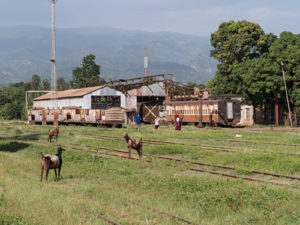 The Old Town Railway Station: The old Moshi Railway Station was built during the Germany colonial rule (1912). The station is no longer in use and appears abandoned for now to the goats and cows. It is still worth visiting especially if you have nothing to do in the evening. You can spot old wagons that are no longer in use or sit somewhere and marvel at the Mount Kilimanjaro. Town residents use the old railway tracks as roads on their way to and from town. When you are done exploring the station, you can sip a bottle of Kilimanjaro beer from an old booking office that has now been turned into a bar.
The Old Town Railway Station: The old Moshi Railway Station was built during the Germany colonial rule (1912). The station is no longer in use and appears abandoned for now to the goats and cows. It is still worth visiting especially if you have nothing to do in the evening. You can spot old wagons that are no longer in use or sit somewhere and marvel at the Mount Kilimanjaro. Town residents use the old railway tracks as roads on their way to and from town. When you are done exploring the station, you can sip a bottle of Kilimanjaro beer from an old booking office that has now been turned into a bar.
Visit Marangu Village: This village is located on the lower slopes of Mount Kilimanjaro. The Chagga people arrange special tours before and after hiking mountain Kilimanjaro to discover waterfalls, unique 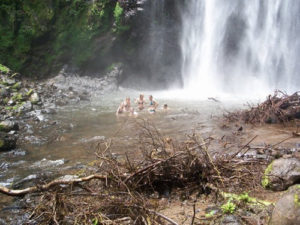 landscape and their own homes. A cultural tour in Marangu village includes experiencing the local food, language, traditional music and dance performances. You can also listen to the tribal elders as they narrate stories about the tribe and the history of mountain climbing in the area. Among the stories are that of Dr. Hans Meyer – the first recorded European to climb Mount Kilimanjaro in 1889. Hans was accompanied up the mountain by a famous local tribesman known as Yohano Lauwo. Lauwo lived for over 115 years and left documented evidence of his adventures hiking mountain Mount Kilimanjaro with countless tourists up to the time he was 70 years old.
landscape and their own homes. A cultural tour in Marangu village includes experiencing the local food, language, traditional music and dance performances. You can also listen to the tribal elders as they narrate stories about the tribe and the history of mountain climbing in the area. Among the stories are that of Dr. Hans Meyer – the first recorded European to climb Mount Kilimanjaro in 1889. Hans was accompanied up the mountain by a famous local tribesman known as Yohano Lauwo. Lauwo lived for over 115 years and left documented evidence of his adventures hiking mountain Mount Kilimanjaro with countless tourists up to the time he was 70 years old.
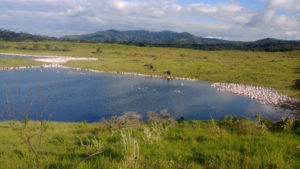 Arusha National Park: This is one of the smallest national parks in Tanzania. The park has abundant wildlife but the unique attractions are the Mount Meru, the Momela Lakes and the Ngurdoto Crater. The Ngurdoto Crater was created about 15 million years ago. It is 3 kilometers wide and teems with birds and other wildlife. The main activities in Arusha National Park are game drives, birding, nature walks and visiting the Momela lakes. The game drives offer visitors opportunities to see antelopes, blue monkeys, buffalos, elephants, giraffe, hippos, hyenas, leopards, warthogs and zebras among other creatures. Unfortunately, because of the great popularity of the nearby Serengeti and Ngorongoro crater, Arusha National Park receives less visitors than it would if it were in another country.
Arusha National Park: This is one of the smallest national parks in Tanzania. The park has abundant wildlife but the unique attractions are the Mount Meru, the Momela Lakes and the Ngurdoto Crater. The Ngurdoto Crater was created about 15 million years ago. It is 3 kilometers wide and teems with birds and other wildlife. The main activities in Arusha National Park are game drives, birding, nature walks and visiting the Momela lakes. The game drives offer visitors opportunities to see antelopes, blue monkeys, buffalos, elephants, giraffe, hippos, hyenas, leopards, warthogs and zebras among other creatures. Unfortunately, because of the great popularity of the nearby Serengeti and Ngorongoro crater, Arusha National Park receives less visitors than it would if it were in another country.
Try the Local Food: Moshi may be a small town but you will not be disappointed when it comes to where to find good food. There are countless Italian, Indian, Asian and other continental restaurants 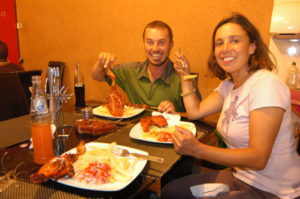 within and outside the town center. Tanzanians love meat but vegetarians should expect special arrangements from all the eat outs. Most if not all offer local Swahili dishes like chapattis, Kiti moto (fried pork), Nyama Choma (Goats meat), Kuku (chicken) and grilled banana. Ugali is the national dish and is made from cassava, millet or sorghum flour. Ugali is never eaten alone but in combination with something like boiled meat of fish. You can also try out Tanzanian Somosa with tea at Pandya Tea Room. The other great places to find tasty local food are Green Bamboo Restaurant, East Africa Pub, Kili Home, Maembe Café, Menu’s Bistro, Pamoja Café, Secret Garden Hotel, Kaka’s Bar and Grill. If you are volunteering or staying longer in the town, you can buy your own food and ingredients from the local markets. The food can be prepared with the help of your local friend or by watching a YouTube video tutorial.
within and outside the town center. Tanzanians love meat but vegetarians should expect special arrangements from all the eat outs. Most if not all offer local Swahili dishes like chapattis, Kiti moto (fried pork), Nyama Choma (Goats meat), Kuku (chicken) and grilled banana. Ugali is the national dish and is made from cassava, millet or sorghum flour. Ugali is never eaten alone but in combination with something like boiled meat of fish. You can also try out Tanzanian Somosa with tea at Pandya Tea Room. The other great places to find tasty local food are Green Bamboo Restaurant, East Africa Pub, Kili Home, Maembe Café, Menu’s Bistro, Pamoja Café, Secret Garden Hotel, Kaka’s Bar and Grill. If you are volunteering or staying longer in the town, you can buy your own food and ingredients from the local markets. The food can be prepared with the help of your local friend or by watching a YouTube video tutorial.
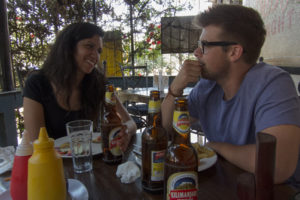 Eat your favorite International Cuisines: If for one reason or another you are not keen on trying the local food, you can visit one of the top high end restaurants and hotels in town for international cuisines. You will find delicious burgers as well as cuisines from Italy, Korea, China and India. The food is tasty and the price is probably much lower than back in your country. The best restaurant for chips and burgers is Chrisburger located along Kibo Road. The chips are served with Fish and Steak. You can also visit Fresh Restaurant along Mawenzi Road for breakfast and snacks (Fried chips and Chicken). Indoitaliano Restaurant next to Shule Street offers some of the best Indian and Italian cuisines. For the best salads, desserts, pizzas and baked eggs, visit Key’s Hotel along Uru Road.
Eat your favorite International Cuisines: If for one reason or another you are not keen on trying the local food, you can visit one of the top high end restaurants and hotels in town for international cuisines. You will find delicious burgers as well as cuisines from Italy, Korea, China and India. The food is tasty and the price is probably much lower than back in your country. The best restaurant for chips and burgers is Chrisburger located along Kibo Road. The chips are served with Fish and Steak. You can also visit Fresh Restaurant along Mawenzi Road for breakfast and snacks (Fried chips and Chicken). Indoitaliano Restaurant next to Shule Street offers some of the best Indian and Italian cuisines. For the best salads, desserts, pizzas and baked eggs, visit Key’s Hotel along Uru Road.
More information about visiting Moshi Town in Tanzania
How do I reach Moshi? The best way to arrive in Moshi is by taking a flight first to Dar es Salaam and then getting another to Kilimanjaro Airport. From Kilimanjaro, you can hire a taxi or wait for your tour 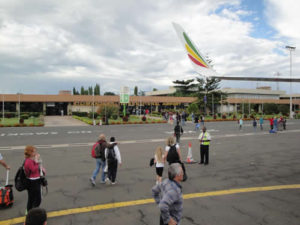 operator to pick you up. There are also direct flights from Masai Mara and Nairobi to Moshi. It is also possible to use road transport from Dar es Salaam, Nairobi, Kampala and Arusha to Moshi. However, traveling by road if tiresome and will require long driving hours. It should be undertaken by one with budget constraints or those who wish to experience the unique African countryside. Buses are the best option for long distance travel and there are many companies like Dar Express with quality vehicles. For the best experience, we recommend that you book first class if you can.
operator to pick you up. There are also direct flights from Masai Mara and Nairobi to Moshi. It is also possible to use road transport from Dar es Salaam, Nairobi, Kampala and Arusha to Moshi. However, traveling by road if tiresome and will require long driving hours. It should be undertaken by one with budget constraints or those who wish to experience the unique African countryside. Buses are the best option for long distance travel and there are many companies like Dar Express with quality vehicles. For the best experience, we recommend that you book first class if you can.
How do I move around in town? Once you are in the town, you have several means of transport to choose from. The most popular means of transport are the local minibuses known as Daladalas. These minibuses can transport up to 30 people and may include domestic animals. It is a cheap means of 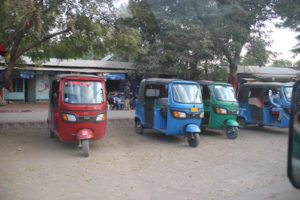 transport to reach the neighboring villages like Marangu and Machame. To get one, you need to go to their main parking space and listen to calls from the conductors indicating the direction they are heading to. Daladalas are an excellent means of transport for those who wish to mingle with the folks in town. If you want a more private tour, you can hire a personal taxi, a boda boda or use the service of a tour operator. Never take a boda boda without a helmet. Always check to ensure that the boda, daladala or taxi is in good mechanical condition before paying or hopping in. Boda bodas are never safe at all especially if you don’t have a helmet. A few of the riders are known thieves in the area, hence be very alert when using any of them outside the city center.
transport to reach the neighboring villages like Marangu and Machame. To get one, you need to go to their main parking space and listen to calls from the conductors indicating the direction they are heading to. Daladalas are an excellent means of transport for those who wish to mingle with the folks in town. If you want a more private tour, you can hire a personal taxi, a boda boda or use the service of a tour operator. Never take a boda boda without a helmet. Always check to ensure that the boda, daladala or taxi is in good mechanical condition before paying or hopping in. Boda bodas are never safe at all especially if you don’t have a helmet. A few of the riders are known thieves in the area, hence be very alert when using any of them outside the city center.
It is important to note that you will be required to have a Tanzanian Visa on arrival if you are an international tourist. Visas can be got from the nearest Tanzanian consulate or Embassy in your country. A Visa can also be got at all major border crossings and airports. Apart from the Tanzanian visa, Visitors are also expected to have a yellow fever vaccination card before entering into the country.
When is the best time to visit Moshi? Moshi has two rainy and dry season. The best time to visit is in the warm months of January to February and also June to September. This is the best time to climb Mount Kilimanjaro. Try to avoid the rainy season if you are planning to climb Mount Kilimanjaro during your stay in Moshi. The rains reduce visibility and cause hiking routes to get slippery. The rains also come with more cloud cover hence limiting the quality of views while hiking up the mountain. The rains come between March to May and also November to the beginning of December.

